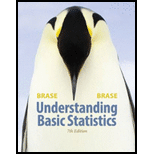
Before you solve Problems 6-10, first classify the problem as one of the following:
Chi-square test of independence or homogeneity
Chi-square goodness of fit
Chi-square for testing
Then in each of the problems when a test is to be performed do the following:
(i) Give the value of the level of significance. State the null and alternate hypotheses.
(ii) Find the sample test statistic.
(iii) Find or estimate the P-value of the sample test statistic.
(iv) Conclude the test.
(v) Interpret the conclusion in the context of the application.
Teacher Ratings: Grades Professor Stone complains that student teacher ratings depend on the grade the student receives. In other words, according to Professor Stone, a teacher who gives good grades gets good ratings, and a teacher who goes had grades gets had ratings. To test this claim, the Student Assembly took a random sample of 300 teacher ratings on which the student's grade fur the course also was indicated. The results are given in the following table. Test the hypothesis that teacher ratings and student grades are independent at the 0.01 level of significance.
| Rating | A | B | c | f (or withdrawal) | Row Total |
| Excellent | 14 | 18 | 15 | 3 | 50 |
| Average | 25 | 35 | 75 | 15 | 150 |
| Poof | 21 | 27 | 40 | 12 | 100 |
| Column Total |
60 | 80 | 110 | 30 | 300 |
Want to see the full answer?
Check out a sample textbook solution
Chapter 11 Solutions
Understanding Basic Statistics
- Harvard University California Institute of Technology Massachusetts Institute of Technology Stanford University Princeton University University of Cambridge University of Oxford University of California, Berkeley Imperial College London Yale University University of California, Los Angeles University of Chicago Johns Hopkins University Cornell University ETH Zurich University of Michigan University of Toronto Columbia University University of Pennsylvania Carnegie Mellon University University of Hong Kong University College London University of Washington Duke University Northwestern University University of Tokyo Georgia Institute of Technology Pohang University of Science and Technology University of California, Santa Barbara University of British Columbia University of North Carolina at Chapel Hill University of California, San Diego University of Illinois at Urbana-Champaign National University of Singapore McGill…arrow_forwardName Harvard University California Institute of Technology Massachusetts Institute of Technology Stanford University Princeton University University of Cambridge University of Oxford University of California, Berkeley Imperial College London Yale University University of California, Los Angeles University of Chicago Johns Hopkins University Cornell University ETH Zurich University of Michigan University of Toronto Columbia University University of Pennsylvania Carnegie Mellon University University of Hong Kong University College London University of Washington Duke University Northwestern University University of Tokyo Georgia Institute of Technology Pohang University of Science and Technology University of California, Santa Barbara University of British Columbia University of North Carolina at Chapel Hill University of California, San Diego University of Illinois at Urbana-Champaign National University of Singapore…arrow_forwardA company found that the daily sales revenue of its flagship product follows a normal distribution with a mean of $4500 and a standard deviation of $450. The company defines a "high-sales day" that is, any day with sales exceeding $4800. please provide a step by step on how to get the answers in excel Q: What percentage of days can the company expect to have "high-sales days" or sales greater than $4800? Q: What is the sales revenue threshold for the bottom 10% of days? (please note that 10% refers to the probability/area under bell curve towards the lower tail of bell curve) Provide answers in the yellow cellsarrow_forward
- Find the critical value for a left-tailed test using the F distribution with a 0.025, degrees of freedom in the numerator=12, and degrees of freedom in the denominator = 50. A portion of the table of critical values of the F-distribution is provided. Click the icon to view the partial table of critical values of the F-distribution. What is the critical value? (Round to two decimal places as needed.)arrow_forwardA retail store manager claims that the average daily sales of the store are $1,500. You aim to test whether the actual average daily sales differ significantly from this claimed value. You can provide your answer by inserting a text box and the answer must include: Null hypothesis, Alternative hypothesis, Show answer (output table/summary table), and Conclusion based on the P value. Showing the calculation is a must. If calculation is missing,so please provide a step by step on the answers Numerical answers in the yellow cellsarrow_forwardShow all workarrow_forward
 Glencoe Algebra 1, Student Edition, 9780079039897...AlgebraISBN:9780079039897Author:CarterPublisher:McGraw Hill
Glencoe Algebra 1, Student Edition, 9780079039897...AlgebraISBN:9780079039897Author:CarterPublisher:McGraw Hill
